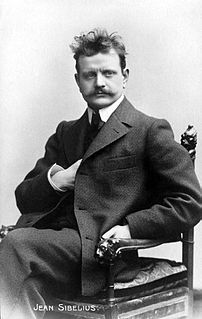
Jean Sibelius was a Finnish composer of the late Romantic and early-modern periods. He is widely regarded as his country's greatest composer, and his music is often credited with having helped Finland develop a national identity during its struggle for independence from Russia.
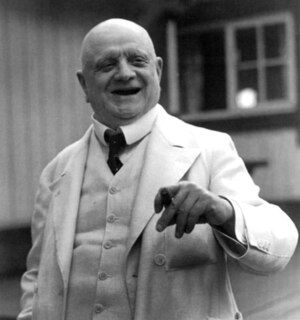
Jean Sibelius's Symphony No. 8 was his final major compositional project, occupying him intermittently from the mid-1920s until around 1938, though he never published it. During this time Sibelius was at the peak of his fame, a national figure in his native Finland and a composer of international stature. A fair copy of at least the first movement was made, but how much of the Eighth Symphony was completed is unknown. Sibelius repeatedly refused to release it for performance, though he continued to assert that he was working on it even after he had, according to later reports from his family, burned the score and associated material, probably in 1945.

Edwin Olin Downes, better known as Olin Downes, was an American music critic, known as "Sibelius's Apostle" for his championship of the music of Jean Sibelius. As critic of The New York Times, he exercised considerable influence on musical opinion, although many of his judgments have not stood the test of time.

The Sibelius Academy is part of the University of the Arts Helsinki and a university-level music school which operates in Helsinki and Kuopio, Finland. It also has an adult education centre in Järvenpää and a training centre in Seinäjoki. The Academy is the only music university in Finland. It is among the biggest European music universities with roughly 1,400 enrolled students.

Ainola, meaning "Aino's Place", was the home of the Finnish composer Jean Sibelius, his wife Aino and their family from the autumn of 1904 until 1972.
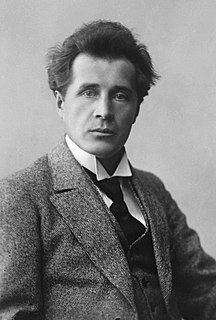
Leevi Antti Madetoja was a Finnish composer, music critic, conductor, and teacher of the late-Romantic and early-modern periods. He is widely recognized as one of the most significant Finnish contemporaries of Jean Sibelius, under whom he studied privately from 1908–10.

Finlandia, Op. 26, is a tone poem by the Finnish composer Jean Sibelius. It was written in 1899 and revised in 1900. The piece was composed for the Press Celebrations of 1899, a covert protest against increasing censorship from the Russian Empire, and was the last of seven pieces performed as an accompaniment to a tableau depicting episodes from Finnish history. The premiere was on 2 July 1900 in Helsinki with the Helsinki Philharmonic Society conducted by Robert Kajanus. A typical performance takes between 7½ and 9 minutes depending on how it is performed.
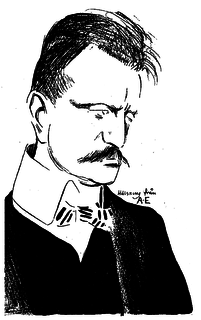
The Symphony No. 2 in D major, Op. 43, by Jean Sibelius was started in winter 1901 in Rapallo, Italy, shortly after the successful premiere of the popular Finlandia, and finished in 1902 in Finland. Sibelius said, "My second symphony is a confession of the soul."
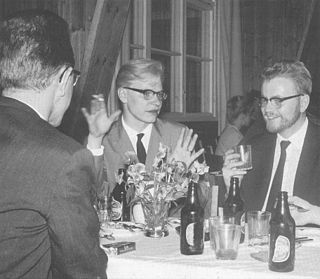
Erkki Olavi Salmenhaara was a Finnish composer and musicologist.
The International Jean Sibelius Violin Competition, named after Finnish composer Jean Sibelius, is a competition for violinists up to age 30. It is held every five years in Helsinki. The first competition took place in year 1965, eight years after the death of the composer to mark the centenary of the composer's birth. The competition is arranged by the Sibelius Society of Finland and the Sibelius Academy.

Kullervo, Op. 7, is a suite of symphonic movements by the Finnish composer Jean Sibelius. It is often referred to as a choral symphony. The third and fifth movements make use of a men's chorus. The third, authorised by the composer for performance as an independent work, also calls for two soloists, a baritone and a soprano. Based on the character of Kullervo in Elias Lönnrot's epic poem Kalevala and using texts from that poem, the work premiered to critical acclaim on 28th April 1892 with Emmy Achté and Abraham Ojanperä as soloists and the composer conducting the Helsinki Orchestral Society.

En saga, Op. 9, is a single-movement tone poem for orchestra written in 1891–92 by the Finnish composer Jean Sibelius. The piece, which likely began as a septet or octet for flute, clarinet, and string ensemble before evolving into an orchestral tone poem, premiered on 16 February 1893 in Helsinki with Sibelius conducting the Helsinki Orchestral Society. A decade later in 1902, Sibelius substantially revised En saga in response to an invitation from Ferruccio Busoni to conduct the piece in Berlin; the tone poem thus stands alongside the Lemminkäinen Suite, the Violin Concerto, The Oceanides, and the Fifth Symphony as one of Sibelius' most overhauled works. The Berlin concert, which occurred a fortnight after Robert Kajanus had premiered the revised piece in Helsinki on 2 November, finally brought Sibelius the German breakthrough he had long desired.

Robert Kajanus was a Finnish conductor, composer, and teacher. In 1882, he founded the Helsinki Orchestral Society, Finland's first professional orchestra. As a conductor, he was also a notable champion and interpreter of the music of Jean Sibelius.
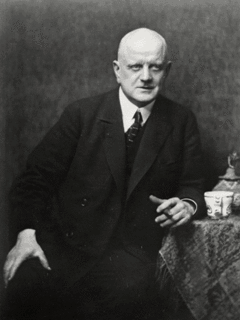
Tapiola, Op. 112, is a tone poem by the Finnish composer Jean Sibelius, written in 1926 on a commission from Walter Damrosch for the New York Philharmonic Society. Tapiola portrays Tapio, the animating forest spirit mentioned throughout the Kalevala. It was premiered by Damrosch on 26 December 1926.
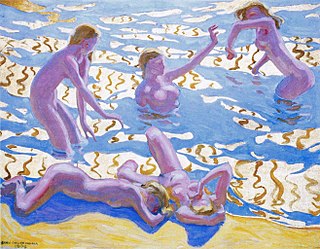
The Oceanides, Op. 73, is a single-movement tone poem for orchestra written in 1913–14 by the Finnish composer Jean Sibelius. The piece, which refers to the nymphs in Greek mythology who inhabited the Mediterranean Sea, premiered on 4 June 1914 at the Norfolk Music Festival in Connecticut with Sibelius conducting. Praised upon its premiere as "the finest evocation of the sea ... ever ... produced in music", the tone poem, in D major, consists of two subjects, said to represent the playful activity of the nymphs and the majesty of the ocean, respectively. Sibelius gradually develops this material over three informal stages: first, a placid ocean; second, a gathering storm; and third, a thunderous wave-crash climax. As the tempest subsides, a final chord sounds, symbolizing the mighty power and limitless expanse of the sea.

The Sibelius Monument by Eila Hiltunen is dedicated to the Finnish composer Jean Sibelius (1865–1957). The monument is located at the Sibelius Park in the district of Töölö in Helsinki, the capital city of Finland.
Glenda Goss is an American author and music historian whose special interests are music and culture, early modernism, critical editing, and European-American points of cultural contact. Her most notable work has revolved around the life and works of the Finnish composer, Jean Sibelius.

The Wood Nymph, Op. 15, is a programmatic tone poem for orchestra composed in 1894 and 1895 by the Finnish composer Jean Sibelius. The ballade, which premiered on 17 April 1895 in Helsinki, Finland, with Sibelius conducting, follows the Swedish writer Viktor Rydberg's 1882 poem of the same title, in which a young man, Björn, wanders into the forest and is seduced and driven to despair by a skogsrå, or wood nymph. Organizationally, the tone poem consists of four informal sections, each of which corresponds to one of the poem's four stanzas and evokes the mood of a particular episode: first, heroic vigor; second, frenetic activity; third, sensual love; and fourth, inconsolable grief.

The Wihuri Sibelius Prize is a music prize awarded by the Wihuri Foundation for International Prizes to prominent composers who have become internationally known and acknowledged. The Wihuri Sibelius Prize is one of the biggest and most prestigious music prizes in the world of classical music. The first Sibelius Prize was awarded to Finnish composer Jean Sibelius, whom the prize was named after, in 1953. By 2021, the Wihuri Foundation for International Prizes has awarded altogether 19 Wihuri Sibelius Prizes, the latest award climbing up to €150,000 and awarded to Finnish composer Jukka Tiensuu. The Wihuri Sibelius Prize winner is selected by a five-member committee that consists of experts from Finnish music institutions. The prize may be awarded to private individuals or organizations regardless of nationality.

The Sibelius Museum is a museum of music, named after the Finnish composer Jean Sibelius. The museum is located close to Turku Cathedral in the historical city centre of Turku on the southwest coast of Finland. It is the only museum devoted to music in Finland. The museum houses a wide collection of historical music instruments from around the world. The archives of the museum include documents The museum was first founded during the 1920s as a seminar for the Department of Musicology at Åbo Akademi University, and has later developed into its own department. The Museum is currently organised and funded by the Åbo Akademi Foundation. The current building was built and opened in 1968 and it was designed by architect Woldemar Baeckman.
















